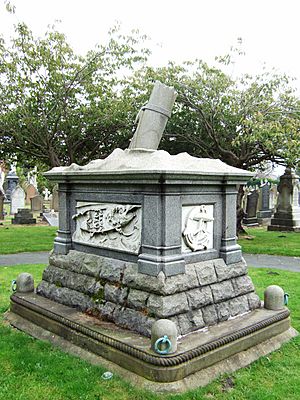Lifeboat Memorial, Southport facts for kids
The Lifeboat Memorial in Southport Cemetery, Southport, Merseyside, England, is a special monument. It remembers 27 brave lifeboatmen from Southport and St Annes. They sadly lost their lives trying to save sailors from a German ship called the Mexico in a terrible storm in 1886. The memorial looks like a stone chest on a tall base. It has carvings and special messages written on it. This important memorial is a Grade II listed building, which means it's a nationally important historical structure.
Contents
History of the Disaster
A Terrible Storm and a Brave Rescue Attempt
On December 9, 1886, a very strong storm hit the coast. A German sailing ship named the Mexico was pushed onto a sandbank called Horse Bank, near Ainsdale. Three lifeboats rushed out to help. These were the Eliza Fernley from Southport, the Laura Janet from St Annes, and the Charles Biggs from Lytham.
The Lytham lifeboat successfully rescued the crew from the Mexico. However, the other two lifeboats, from Southport and St Annes, tragically overturned. All thirteen crew members from the St Annes lifeboat were lost. Only two of the sixteen crew members from the Southport lifeboat survived. This event was the worst disaster in the history of the Royal National Lifeboat Institution.
Building the Memorial
After the disaster, John Unwin, who was the mayor of Southport, started a special fund. This fund raised a lot of money, about £31,000. Most of this money went to help the families of the brave men who were lost.
In January 1887, the fund allowed £200 for each of the three local towns to build monuments. The Southport committee decided to hold a competition to design a monument for the cemetery. It was not supposed to cost more than £170. The design by Ernest Walter Johnson was chosen, and £185 was spent to build it. The sculptor who created the memorial was Thomas Robinson.
What the Memorial Looks Like
Materials and Size
The memorial is made from sandstone and shiny granite. It also has special plaques made of marble. It stands about 2.4 metres (8 feet) tall and is about 2.6 metres (8.5 feet) long.
Design Features
The memorial looks like a stone chest sitting on a tall plinth (a heavy base). This base stands on a foundation made of ashlar (cut stone blocks). The foundation is decorated with a pattern that looks like rope. At each corner, there is a small post called a bollard, with an iron ring for mooring (tying up) a boat.
The tall plinth is made of sandstone, and the chest on top is made of granite. There are pilasters (flat columns) on the corners of the chest. Each side has a sunken marble plaque. Above these is a cornice (a decorative ledge).
Symbolic Carving and Inscriptions
On the very top of the memorial, there is a powerful carving. It shows a broken mast sticking out at an angle through crashing waves. This represents the ship that was lost.
Two of the marble panels have messages carved into them. The panel on the west side has a relief carving. This carving shows a view from above of a sinking lifeboat and its crew, surrounded by waves. The messages on the memorial include these words:
- IN GRATEFUL MEMORY OF
- FOURTEEN OF THE HEROIC CREW OF THE SOUTHPORT LIFEBOAT
- "ELIZA FEARNLEY"
- WHO TOGETHER WITH THE CREW OF THE ST ANNE'S LIFEBOAT PERISHED ON
- A GALLANT EFFORT TO RESCUE THE CREW OF THE GERMAN BARQUE "MEXICO"
- WRECKED ON THIS COAST ON THE NIGHT OF THE 9TH DECEMBER 1886
- GREATER LOVE HATH NO MAN THAT THIS THAT A MAN LAY DOWN HIS LIFE FOR HIS FRIENDS
Importance of the Memorial
The Lifeboat Memorial was officially recognized as a Grade II listed building on July 29, 1999. A Grade II listing means that a building or structure is considered to be of "national importance and special interest." It helps protect these important historical sites.
Other Related Monuments
The fund that helped build the Southport memorial also paid for three other monuments to remember the disaster. There is another one in Southport, and memorials in Lytham and St Annes.
- The other Southport memorial is an obelisk (a tall, pointed stone pillar) on the Promenade. It also remembers other events. This one is also a Grade II listed building.
- The memorial in Lytham is in the churchyard of St Cuthbert's Church. It looks like a pinnacled tabernacle (a small, decorative shrine with pointed tops). It is also Grade II listed.
- The St Annes memorial stands on the Promenade. It is a statue of a lifeboatman looking out to sea. This memorial is also Grade II listed.


